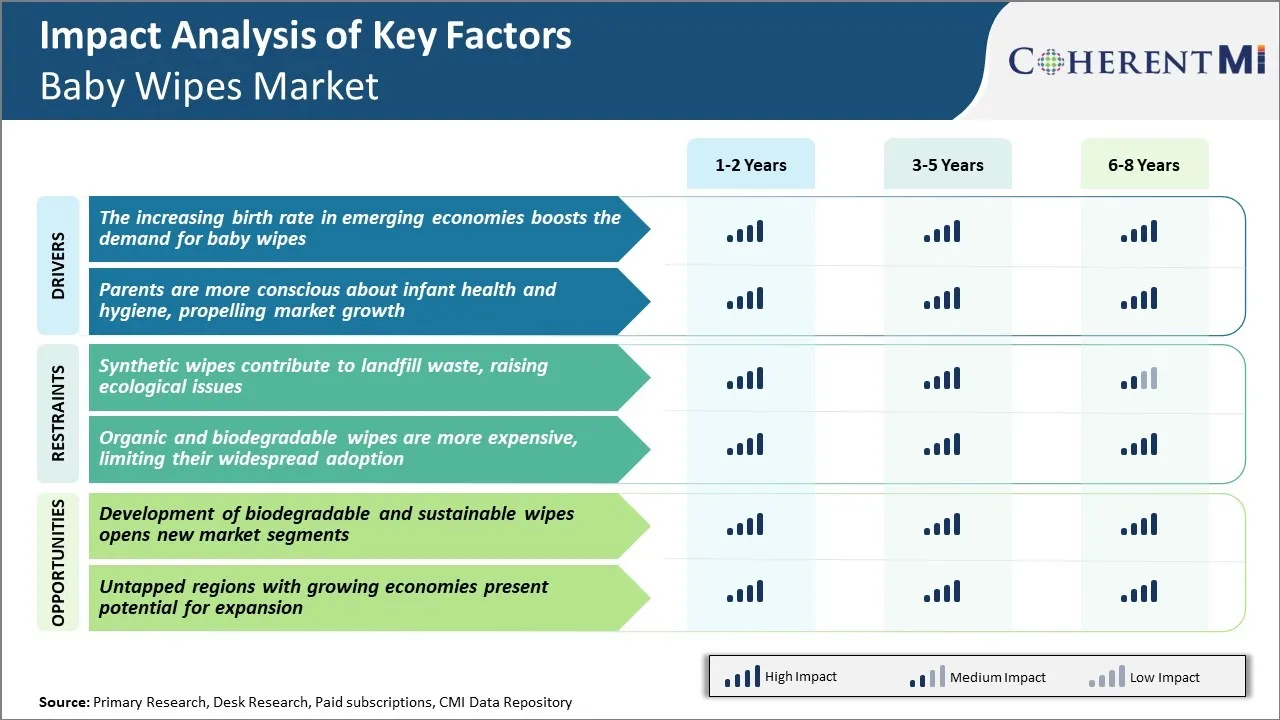Baby Wipes Market Trends
Market Driver - The Increasing Birth Rate in Emerging Economies Boosts the Demand for Baby Wipes
Rapid growth in infant population naturally drives greater consumption of essential baby care products. And one such indispensable item is baby wipes. In these developing regions where access to basic amenities like running water may not always be reliable, parents have come to rely on convenient pack of baby wipes to clean and freshen up their little ones throughout the day. Wipes are easy to carry around, can be used even outside the home and do not require a separate wash up afterwards making them very practical.
Moreover, as more women join the workforce in urban areas, dual income families have less time to spend on chores like giving regular baths to infants. Wipes have significantly reduced the time spent on baby hygiene routines. Working moms in particular seek solutions that make caring for children hassle-free yet effective.
Therefore, baby wipes manufacturers are well poised to capture the demand from an exploding young population as well as affluent consumers through superior formulations, cute designs and multi-packs. Overall, the confluence of demographic and economic changes in developing regions signifies immense scope for expansion of the baby wipes industry worldwide.
Market Driver - Parents are More Conscious about Infant Health and Hygiene, Propelling Market Growth
In the modern digital era, new parents are constantly fed information on best practices from a wide variety of sources both online and offline. Social media, parenting websites, magazines as well as pediatricians all emphasize the importance of hygiene and a clean environment for baby’s overall wellbeing.
Today’s Generation of millennial moms and dads extensively research products and ingredients to ensure only the safest options are used. They scrutinize labels checking for harmful chemicals, allergens, certifications before purchasing items for babies. This high focus on natural, organic cleaning translates directly into increased demand for features like fragrance-free, hypoallergenic wipes made from plant-based materials instead of synthetic ones.
Brands have accordingly revamped offerings catering to health-conscious parents. Wipes now boast extra soft textures, natural extracts like aloe vera, chamomile to soothe and moisturize the baby bottom after each use. Some variants are enriched with probiotics, vitamins or other immunity boosters. Such innovations with wellness-promoting formulations find more takers willing to pay a premium for quality.
Parents wish to provide the best possible hygiene routine and care for their little one’s wellbeing through right products. Overall parental concern for infant sanitation and safety forms a solid pillar propelling steady gains for the baby wipes segment.

Market Challenge - Synthetic Wipes Contribute to Landfill Waste, Raising Ecological Issues
One of the key challenges facing the baby wipes market is the use of synthetic materials that are not biodegradable. Most baby wipes currently sold contain plastics like polyethylene and polypropylene that don't break down in landfills over long periods of time.
As baby wipes are meant to be single-use products that are disposed after each diaper change, their non-biodegradable nature leads to a huge amount of plastic waste entering the municipal solid waste stream every year. Statistics show that over 100 billion baby wipes are estimated to end up in landfills annually across major markets worldwide.
This accumulation of plastic litter in overfilled landfills is exacerbating ecological issues like microplastic pollution. Harmful chemicals from synthetic wipes can leach into groundwater sources over many decades. There is also rising public concerns about the carbon footprint of productions processes that create non-renewable plastics for baby wipes.
Environmental agencies in Europe and North America have voiced concerns about the lack of degradability of common baby wipe ingredients. This adds regulatory and reputational pressure on brands focusing on meeting sustainability goals. Overall, the usage of petroleum-based plastics poses a significant challenge to the long-term growth prospects of the baby wipes industry from an environmental perspective.
Market Opportunity – Development of Biodegradable and Sustainable Wipes Opens New Market Segments
One major opportunity for players in the baby wipes market is the rising demand for more eco-friendly product formulations. With increasing awareness around issues like plastic pollution and climate change, consumers are looking for sustainable alternatives in personal care categories like baby care.
The development of biodegradable wipes made from plant-based fibers like bamboo, organic cotton and wood pulp presents a massive opportunity to capture this consumer shift towards green options. Such natural materials enable wipes to completely degrade within a few months of disposal, reducing environmental footprint.
Market research shows the biodegradable wipes segment is expected to become one of the fastest growing categories, expanding at a CAGR of over 8% in the next 5 years. This opens up opportunities to launch novel product lines positioned around sustainability.
Leading companies are innovating unique recipes combining biopolymers with natural antibacterial essences approved for baby skin. There is chance to command a premium for ethical offerings and build brand crusading for causes like ocean plastic reduction. Overall, biodegradable wipes enable gaining first-mover advantage in the expanding wellness-focused natural personal care sector.